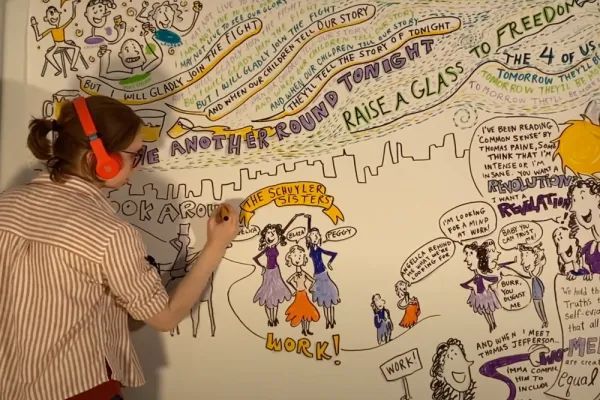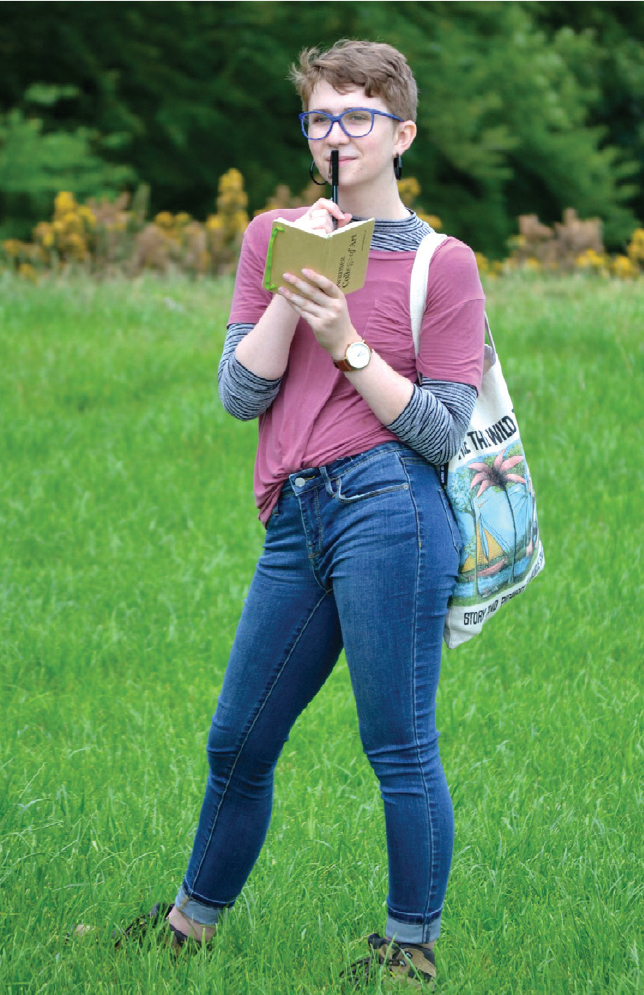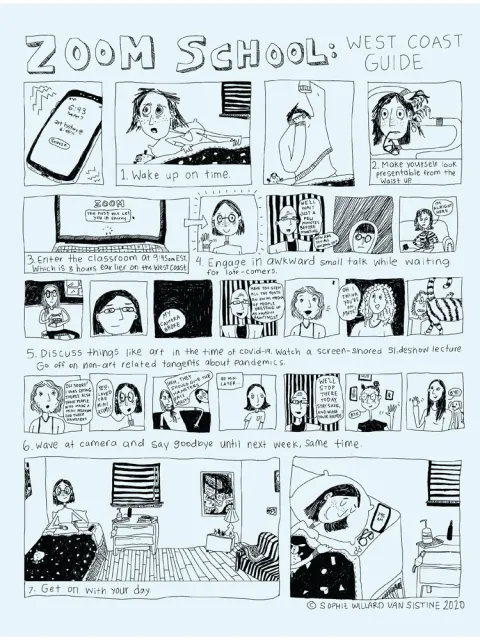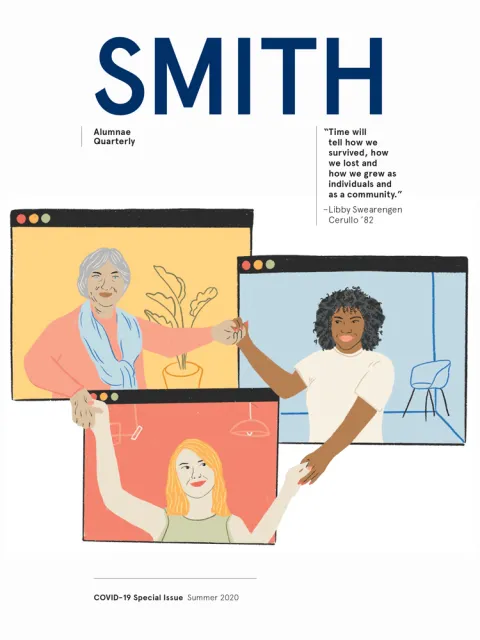Quick on the Draw
Campus Life

Published June 17, 2020
Here’s how the creative process happens. When she is drawing in her characteristic cartoony style, Sophie Willard Van Sistine ’22 of Claremont, California, thinks far ahead about what words and images she will use to tell her story.
She starts with a black pen on white paper and a loose idea in mind. She likes the permanence of a pen, and she likes to see where her hand takes her. If she makes a mistake, she knows she can’t erase it, so it becomes part of the drawing, and she is compelled to incorporate it into whatever comes next. Not surprisingly, she is constantly changing her plans, on the spot, as her ideas evolve.
For Van Sistine—once a theatre major and now a studio art major—it will always be about the storytelling.
 MY DRAWINGS usually end up a bit wonky because of constantly having to evolve with the work itself, but that’s the goal. I want my drawings to feel alive and raw. I like to incorporate a bit of magical realism into my drawings. It’s a way to interpret the words I write in a more abstract way. So, the wonkiness lends itself to that sense of distorted reality.
MY DRAWINGS usually end up a bit wonky because of constantly having to evolve with the work itself, but that’s the goal. I want my drawings to feel alive and raw. I like to incorporate a bit of magical realism into my drawings. It’s a way to interpret the words I write in a more abstract way. So, the wonkiness lends itself to that sense of distorted reality.
DRAWING IS LIKE improvisation, which is another aspect of theater that I loved. I can scan my drawings into Photoshop after and fill them in with scribbles of color if I want to.
BY THE SPRING OF MY FIRST YEAR at Smith, I had already decided the theatre major wasn’t for me, so I was exploring my options. I took Pam Petro’s class [Nonfiction in Words and Pictures] because it looked like fun. I knew I liked art and writing, so what could be better than the combination of the two? Within the first few weeks we read selections from graphic novels, responded to innovative and unconventional writing prompts from Lynda Barry’s book What It Is and created a few short word and image pieces of our own. Something just clicked.
ART AND WRITING were always side interests of mine. Pam’s class made me realize combining art and writing was the thing I wanted to do. It was the way I wanted to communicate with and make sense of the world. Writing comics incorporates the storytelling and character development elements of theater that I love, but it also gives me the creative freedom to work on my own time as I figure out how to articulate and illustrate the things I want to say. Pam’s enthusiasm about comics and her encouragement was also a big part of why I stuck with comics. It’s really nice to find a professor you click with, who sees you and who helps you realize your potential.
I PARTICIPATED IN the Dylan Thomas Summer School in creative writing at the University of Wales Trinity Saint David in West Wales in 2018. I was quite drawn to Wales. The first thing that struck me—given its landscape of rolling hills—is that everything is green, and everyone is incredibly kind. By December that year, I had completed a 116-page comic memoir about that experience of forming community with other writers during our time together in Wales.
THROUGH IMAGE—a language of emotion, creativity and imagination—I illustrated my cartoon-self exploring these relationships in a semirealistic, semiabstract and synesthetic visual world. I drew the past into the present, contemplating stories as liminal spaces of connection that transcend time. Combining word and image, I discovered that storytelling is a form of empathy, which allows us to inhabit multiple worldviews and find new solutions to problems.—As told to Jan Ebbets

This story appears in the Summer 2020 issue of the Smith Alumnae Quarterly.

A Semester Like No Other: How the class of 2020 left campus with a proper send-off.
Smith’s All-Hands Crisis Response: Entire campus community takes up an array of challenges presented by a dangerous pandemic.
Connection Out of Isolation: 12 voices collaborate on a poem for our time.
Mission to Make Masks: Students, staff rev up sewing machines to fill a community need.
Race for a Vaccine: Dr. Annie De Groot ’78 and her biotech firm are on the front line to stop COVID-19 in its tracks.
Virtual Togetherness: Quarantines fall away as Smith friends Zoom into one another’s living rooms.
Echoes of a Pandemic: From canceled classes to campus quarantines, effects of the 1918 Spanish flu ring familiar.
Finding the Funny: An improv comedian’s tips for staying sane in the pandemic.
How Can I Help? From online classes to concerts and community fundraisers, alumnae find creative ways to ease the burden of those in need.
Feeling Community Through My Window: Teresa Kábana ’92 sends a dispatch from Madrid.
The Morning Call That Never Came: Death of a parent in the age of COVID-19 carries an extra layer of grief.
Racialization of Infectious Disease: As viruses spread, so does discrimination against marginalized groups.
Dawn of a New Day: Faith leaders impart messages of hope, acceptance and belief in our collective power to work for a better world.
Sophie Willard Van Sistine ’22 creates an illustration inspired by the “Schuyler Sisters” song from the musical “Hamilton.”